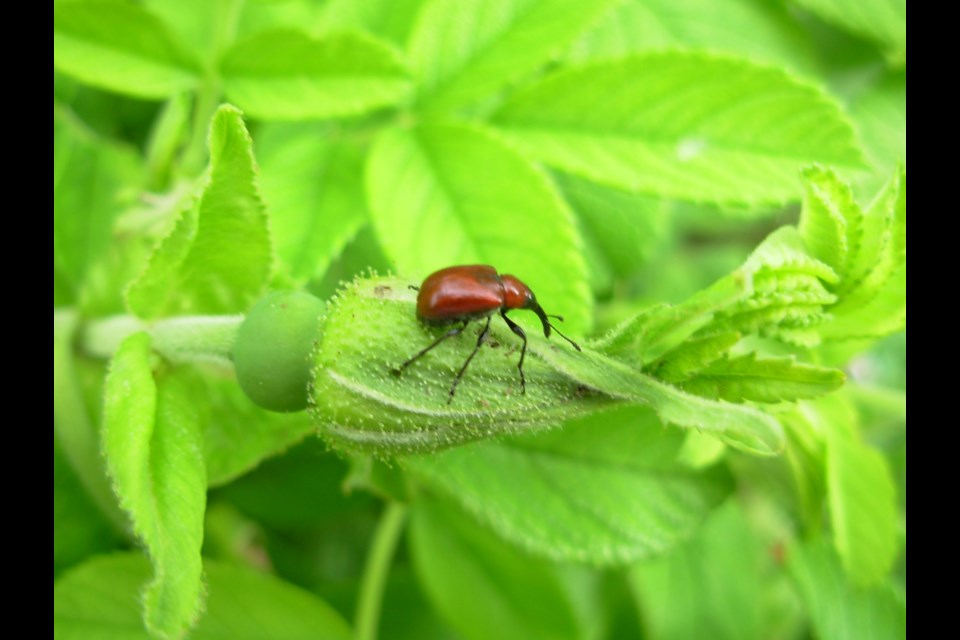Many gardeners, having been made aware of the beneficial work of bees and other pollinators in food production, are starting to incorporate native plants into their landscapes to encourage the success of native pollinators.
The best roses for the native bees are most likely the native roses, such as Rosa arkansa, Rosa woodsii and Rosa acicularis. But these may not be appropriate for many of our gardens as they can spread aggressively and may not bloom profusely.
Scent, colour and shape attract bees to flowers. The stronger the scent in a rose, usually the higher the nectar content. Some bees prefer tube-like flowers whereas many bumblebees prefer a large landing pad. It is not uncommon to see several bees foraging on the heads of large sunflowers.
Roses bred for our harsh prairie climate, often have traded their heavenly scent for hardiness. So to attract bees to your yard, it is essential to provide that scent with other companion plants such as centaurea, catmints, giant hyssop and spireas. Another way is to incorporate rugosa roses, which tend to be more fragrant and will attract bees throughout the day. Among the rugosas are: ‘Hansa’, (found in old farm yards); the Bugnet roses developed by Georges Bugnet in Alberta; ‘Henry Hudson’ developed in Ottawa by Felicitas Svejda; and finally the Pavement roses which were developed in Germany, but are perfectly hardy here on the prairies. The Purple Pavement’ rose thrives in the Heritage Rose Garden at the Forestry Farm Park, where others are eaten to about a foot off the ground by deer. ‘Purple Pavement’ roses appear to be somewhat deer resistant and are always teaming with bee activity.
It is thought that bees do not like dark colours or can't see the colour red. So, if you are trying to attract pollinators, avoid dark red hues such as ‘Cuthbert Grant.’ It’s a beautiful rose, but I have never seen bees on it.
Compared to other flowers, roses produce very little nectar, so bees won't stop at each flower for very long. Bee activity among the Parkland and Explorer roses is heaviest in the early morning hours when they are most fragrant and new flowers are opening. To provide roses with a larger landing pad, plant varieties that have single to semi-double flowers (those with 5 to 15 petals). They provide lots of pollen and have more stamens for bees to forage.
Many other insects aid in the pollination of roses and are beneficial for different reasons, such as ants or lady beetles that control aphids. However, some insects can prove quite destructive, chief among these are the rose weevil or rose curculio which frequents the light-coloured Pavement roses, but can also visit other varieties. Weevils drill holes in the rose buds and then suck out all the juices of the young bud, often preventing the buds from opening. Like the lily beetle, the best method of control is to pick them off and crush them underfoot. Or, catch them in a jar of water, as they drop from the plant to the ground.
Sawflies are important pollinators of crops, but their larvae, which resemble little green caterpillars which hang out underneath freshly grown leaves, can do considerable damage. If a small area is of concern, often just the new lower branches, you can pick them off and prune out any unsightly growth. I often disregard minimal damage, but keep an eye open to ensure it stays localized. For larger infestations, consider the use of insecticide soap to deter larvae from attacking the rest of the plant. Finally, leafcutter bees may take some nice circular pieces from the edges of some of your rose foliage, but this scarcely hurts the rose and provides good nesting material for the bees.
And how do you tell that the pollinators have been on the job? Well. rose hips of course!
— This column is provided courtesy of the Saskatchewan Perennial Society (SPS; [email protected] ). Check our website (www.saskperennial.ca) or Facebook page (www.facebook.com/saskperennial) for a list of upcoming gardening events.




